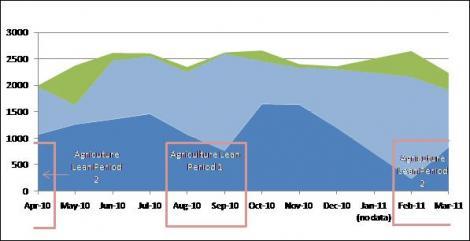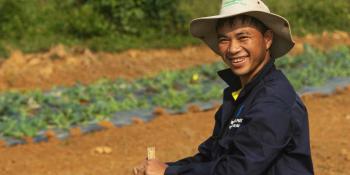Analysis of climate impacts on food security and livelihoods in Nepal

by Krishna Krishnamurthy
Nepal is one of the most vulnerable countries to climate risks, and food security is especially sensitive to climate variability. For example, over the last decade, around 30,845 hectares of land owned by almost 5% of households became uncultivable due to climate-related hazards. In the Eastern Terai, too, the unusually low rains of 2005/2006 associated with the early monsoon resulted in crop losses of 30%; the cold wave of 1997/1998 also had negative impacts on agricultural productivity resulting in losses of up to 38% for chickpea and lentils, and 28% for potato.
Communities, too, have reported significant impacts on agriculture. In the Hills, the lack of sufficient precipitation is affecting paddy rice and wheat production. Communities in the Salyan district have diversified to less preferred crops due to the lack of precipitation.
To better understand the relationship between climate risk, livelihoods and food security in Nepal, the United Nations World Food Programme (WFP) is working in close collaboration with the Nepal Planning Commission (NPC) and the CGIAR Research Program on Climate Change, Agriculture and Food Security (CCAFS) to develop a set of analytical tools and methods.
WFP, the NPC and CCAFS are developing analysis that presents an innovative method which integrates detailed climate analysis with cutting-edge food security information to identify relationships between historical climate and food security trends as well as current vulnerabilities, and uses this information to define priorities for interventions in close consultation with partners.
One of the key findings of the analysis is that access to food markets is one of the critical components of food security. This is especially the case in the mountain areas, where households depend heavily on markets and in-kind contributions during the agricultural lean seasons, despite limited market access and infrastructure. If winter precipitation continues to decline (as most models suggest), food access could be affected in two inter-related ways. First, reduced winter crop production due to lower post-monsoon precipitation would force households to purchase more of their food. Second, climate-induced food price volatility could require households to spend more of their income on food. In addition, climate-related disasters limit physical access to markets.


![]()
This analysis is part of the Resilience Project Initiative coordinated by WFP’s Office for Climate Change, Environment and Disaster Risk Reduction. For more information, please visit www.resilienceweb.org
More information
Read more about Climate Change, Agriculture and Food Security work in South Asia.
This blog post was written by Krishna Krishnamurthy, Climate Change and Hunger Analyst at the World Food Programme (WFP), Office for Climate Change, Environment and Disaster Risk Reduction, WFP.


